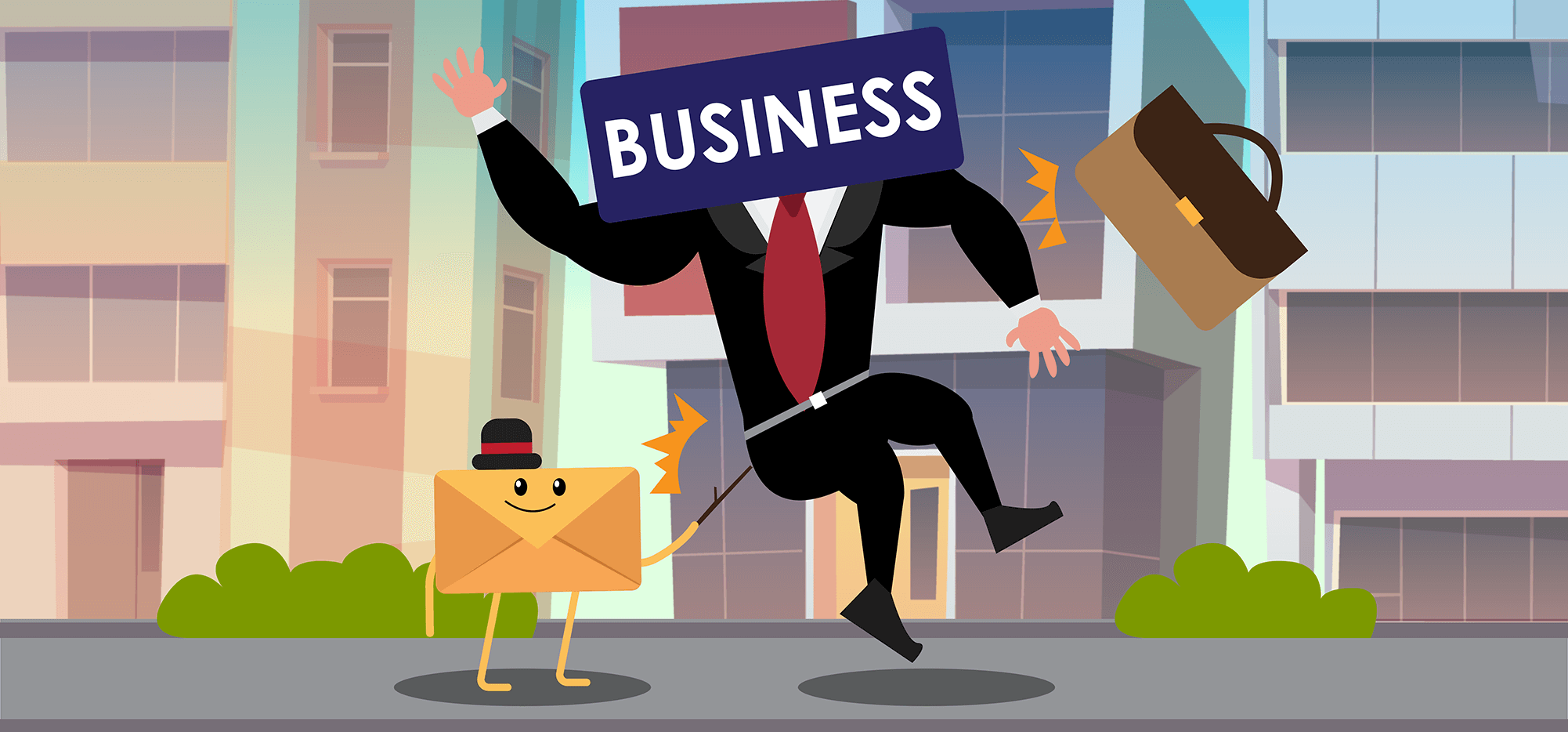
PAS copywriting is a popular sales technique that blends personalization and emotions into a highly-effective cocktail. Because, after all, 95% of sales decisions are emotional.
It’s not easy to properly pull off the PAS (Problem-Agitate-Solve) method in cold email. It takes a lot of skill. But when you get good at it, it can be some of the most effective copy you’ll ever write.
In this article, we’ll walk through the steps of the PAS copywriting method for cold email and share strategies for maximizing each part of the process.
Throughout the article, we’ll also look at a cold email I received using the PAS technique and build a much, much stronger template.
So you don’t make any faux pas.
Ahem.
Let’s get started then.
PAS Copywriting: Table of Contents
- What Does PAS Stand For?
- 1. Problem: Accurately Identify What’s Causing Pain for Your Prospect
- 2. Agitate: Describe the Chilling Consequences of Leaving the Problem Unsolved
- 3. Solve: Prove How Your Offer Is the Solution of Their Dreams
- 4. Call-to-Action: How to End Your PAS Email
- 5. The Best Automated Follow-Up to a PAS Campaign
- PAS Copywriting for Cold Email: Takeaways and Next Steps
What Does PAS Stand For?
PAS stands for Problem-Agitate-Solve. (Or, depending on who you talk to, Pain-Agitate-Solution.) It’s a popular and highly-effective copywriting method for cold email, short- and long-form sales copy, and even social media ads.
The PAS copywriting formula follows a three-step process:
- Accurately identify your prospect’s pressing problem
- Agitate the problem by discussing the short- and long-term consequences of leaving it unsolved
- Prove how your offer solves the problem and they must act to get that solution
Let’s build a cold email campaign using the PAS method.
1. Problem: Accurately Identify What’s Causing Pain for Your Prospect
What problem does your product or service solve — and who has that problem?
Ideally, you’ll identify the people for whom that problem is their biggest pain point. As I’ll discuss below, you don’t necessarily have to solve people’s biggest problem — but you’ll find a higher success rate if you do.
How do you identify your prospect’s problem?
Are you talking to your target customers? Or perhaps you’re in the same industry and now you’re also branching out to help others in the business? However you get there — you need to have a full understanding of your customers before you can use the PAS method.
PAS is a psychologically-driven copywriting technique. So you need to be deep inside your target customers’ minds to pull it off.
Here’s a personal example. In a past life, I created and sold a board game. And I naively assumed the problem it was solving was “a way to have fun at parties.” That wasn’t it. It turned out the problem it solved was “grandma needs a gift her grandkid will actually think is cool.” Unfortunately, I figured that out too late; if I’d known that up front, everything about the game (from design to gameplay to marketing) would have been different.
You can’t solve your customers’ problem until you accurately recognize what that problem is. Once you do, you’ll understand the consequences for your customers if the problem goes unsolved.
That enables you to take them on an emotional journey through your copy — then offer a solution.
What if my product/service doesn’t solve someone’s biggest problem
People have more than one problem. It’s great if you can identify their biggest problem — and that happens to be the problem your product or service solves. But if your product/service doesn’t solve their biggest problem, make sure it solves a major one.
For instance, let’s say you sell bookkeeping services to real estate agents. Is bookkeeping their number one problem?
Likely no, their top problem is (probably) getting more listings.
But is bookkeeping a huge pain for realtors, who are often in solo entrepreneurial businesses with lots of expenses and large amounts of money going in and out? Absolutely.
As long as you’re solving a real problem, you can vividly illustrate the stakes of not solving it, and you make it clear why you’re the best one to solve it today — PAS will work for you.
Putting together the “Problem” section of your email
For this article, we’ll use an example (based on an actual cold email I received) of a B2B company that captures website visitor data.
I’ll compare the real email I got with a version I’ve created that incorporates the PAS copywriting method.
The original email I received:
Subject: Meeting tomorrow
Message: Hi Sam,
I noticed [company] website doesn’t capture data about which businesses are viewing the content of commercial partners.
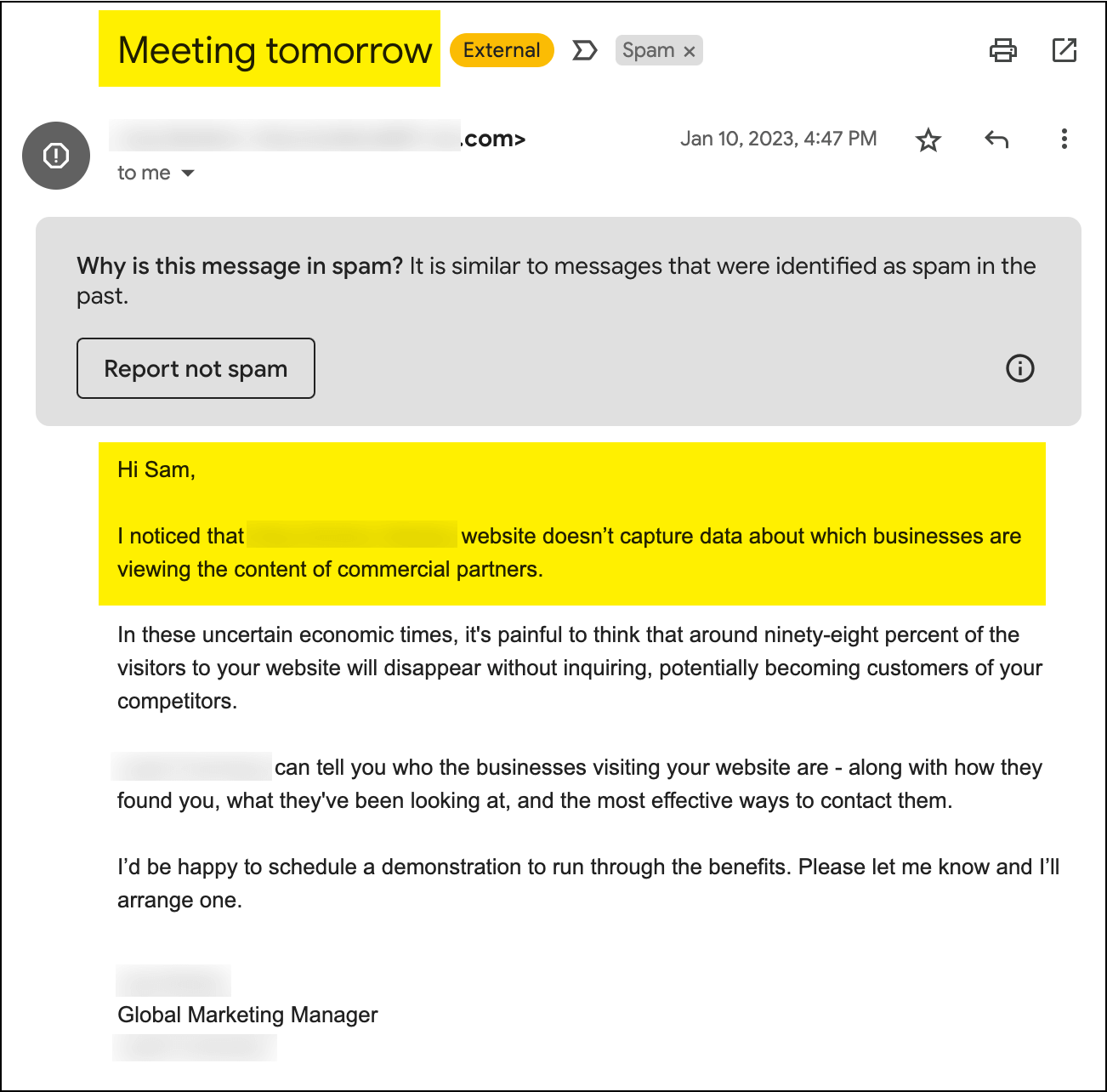
While this identified a problem, is it a pressing problem? Maybe… but it’s not personalized or tailored to me. At all. And based on how they’re stating the problem, there’s no emotional reaction. Even if this was my primary problem, nothing about the copywriting here triggers my brain’s fear centers.
Here’s my rewrite.
Subject: Your site got 99.7k visits in Jan. — turn that into leads
Message: Hello!
People are visiting {SiteName}’s website. (99.7k last month according to Similarweb). That’s 99.7k potential leads! But almost all of them leave without a trace.
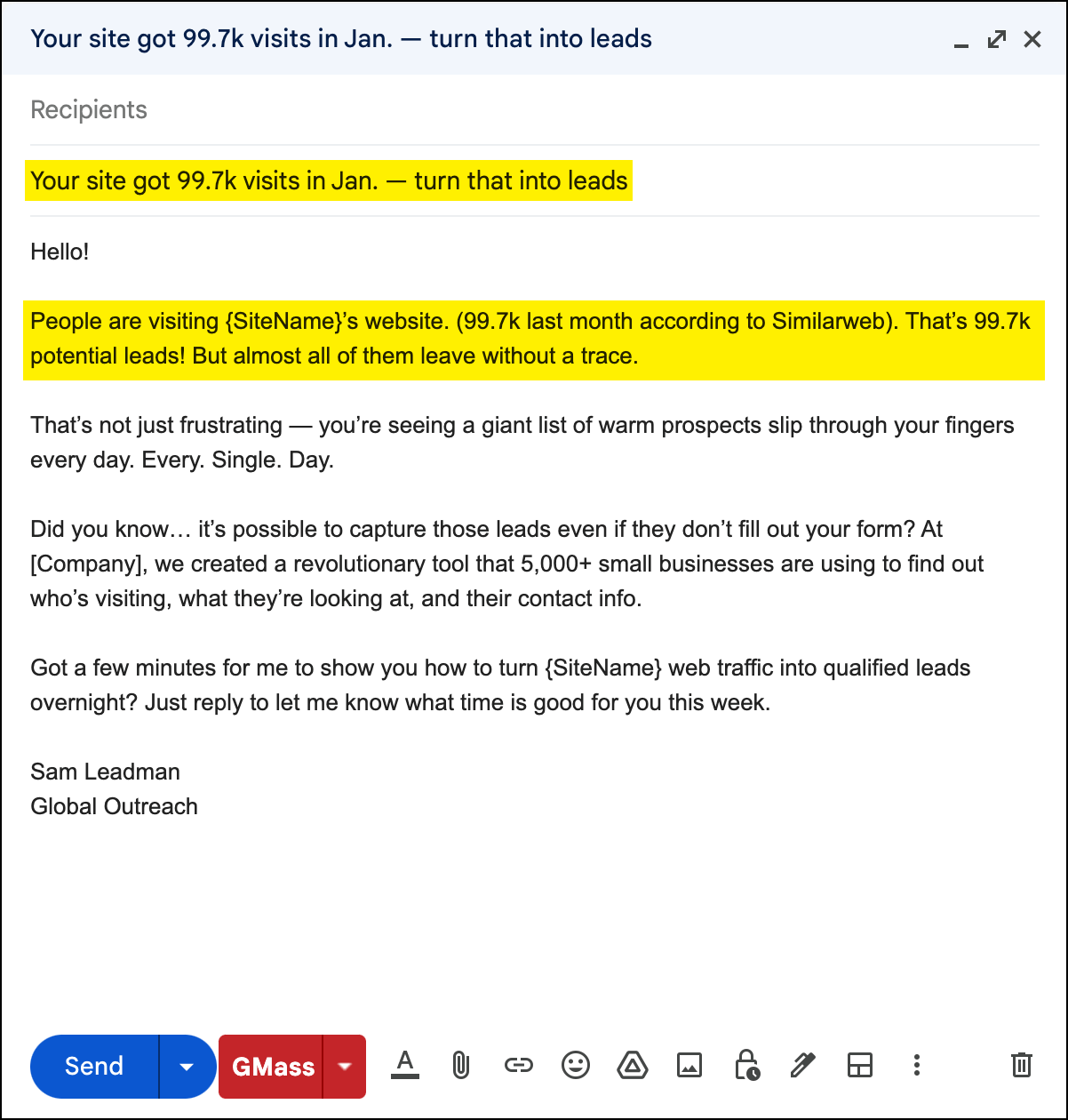
I’m doing a lot of heavy lifting with this series of short sentences.
I recognize the prospect’s biggest problem (need more leads) and show how leads are slipping through their fingers.
My email is personalized. And not by showing off that I researched someone’s name or what college they went to. (Please permanently retire the: “I see you went to [college], impressive!” opening. I cover that a lot in my article on how to start an email.) It’s personalized because I recognize their specific issue and have relevant data to back it up.
This opening takes the prospect on a journey. I turned the problem into a story. And by the end of reading that story, my goal is for the prospect to feel a pit forming in their stomach.
2. Agitate: Describe the Chilling Consequences of Leaving the Problem Unsolved
The agitation section is the “unique” part of the PAS method compared to other methods.
Cold emails should be short — but we’re going to allocate a good chunk of that limited space to twisting the knife about the prospect’s problem.
The “agitate” section is where we’re going for a big emotional response. After the prospect reads this, we want them to feel like they must solve the problem ASAP.
At the same time… we don’t want to send the person running to their therapist. We’re going to empathize with the problem while we agitate.
Ways to agitate the problem in a PAS email
Here are some methods to agitate the problem:
- Enumerate the consequences of not solving the problem. Demonstrate the long-term problems of missing out. For example, you could do the math (“losing out on 20 monthly customers is $120,000 in lost revenue this year”).
- Show how a competitor has solved the problem. Show how a competitor is thriving against your prospect because they took care of the pressing problem.
- Identify the emotions they feel because of the problem. For instance, a recruiter offering to find engineering candidates for a company might discuss how the hiring process is “frustrating” or “time-consuming” or “feels impossible.”
- Give an example of a company that left the problem unchecked. Is there a famous (or not-so-famous) industry example of a company that left the problem unsolved? Point to it. No one wants their company to join that list of infamy.
Putting together the “Agitate” section of your email
The original email I received:
In these uncertain economic times, it’s painful to think that around ninety-eight percent of the visitors to your website will disappear without inquiring, potentially becoming customers of your competitors.
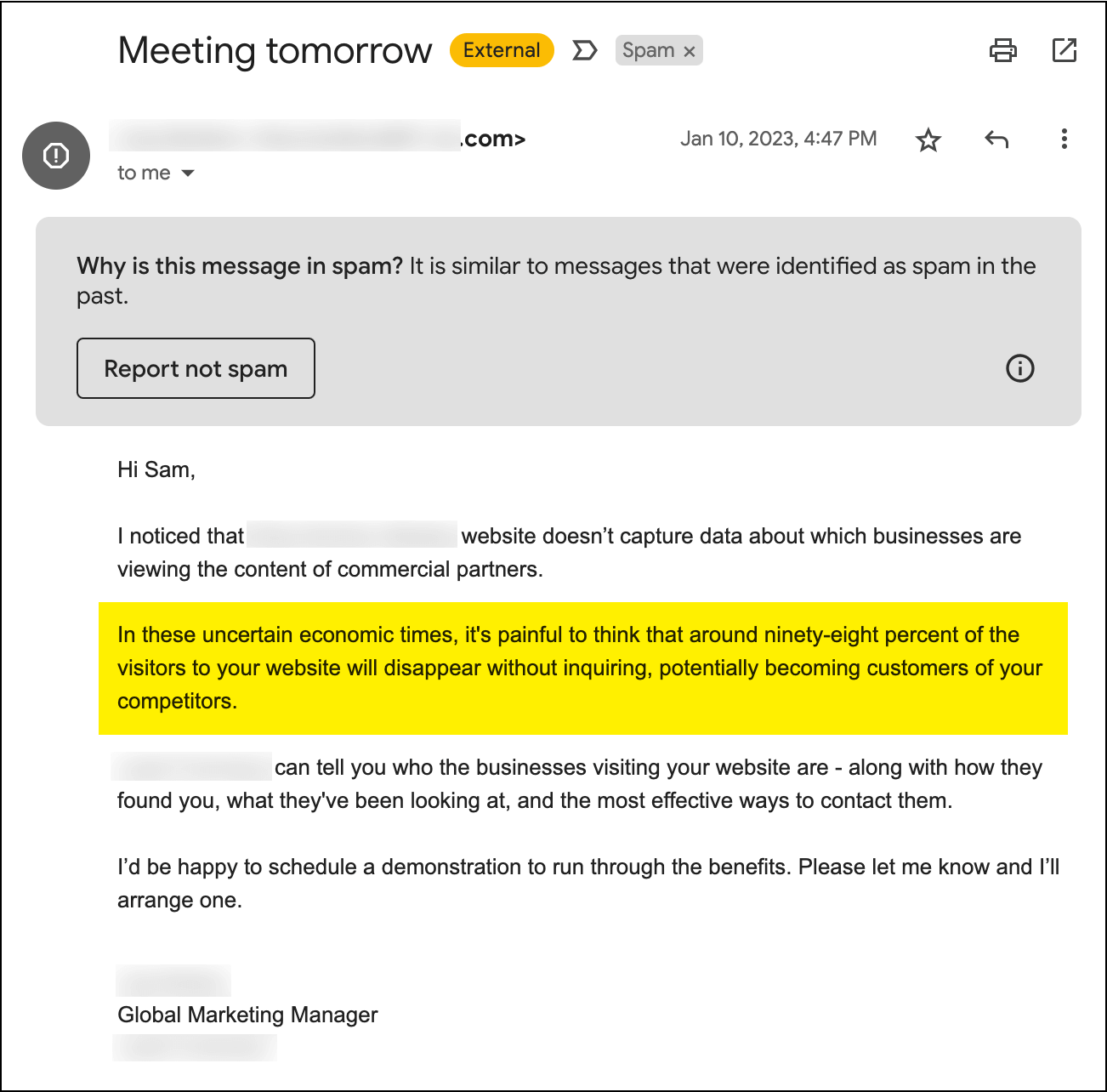
They’re trying to agitate here. There are a few valuable nuggets of information here… surrounded by a lot of cliches and extra words.
Here’s my PAS rewrite.
That’s not just frustrating — you’re seeing a giant list of warm prospects slip through your fingers every day. Every. Single. Day.
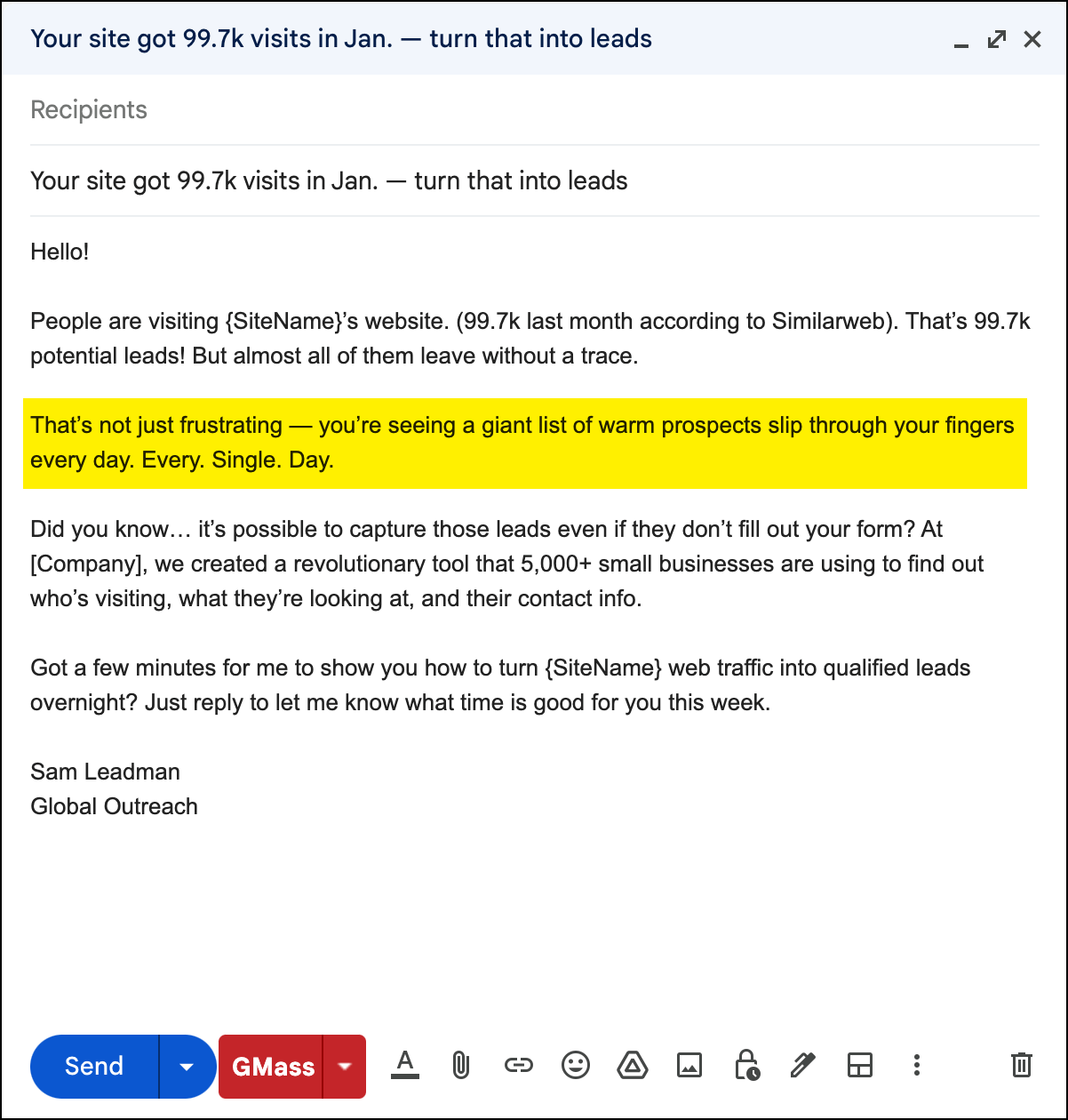
I’m identifying and pushing on emotions here.
My use of language is calculated. The “Every. Single. Day.” part is what really sells this email. The way I phrased that is designed to make the prospect slow down and have each word bother them a little more about the missed opportunity.
At the same time, I’m empathizing with the problem. I’m not calling the prospect a fool for missing these opportunities. I’m showing them I get it. And because I get it… now it’s time to show I’m the right person to solve it.
3. Solve: Prove How Your Offer Is the Solution of Their Dreams
You’ve now set up the problem and made the prospect feel unsettled over the fact that the problem remains unsolved.
Time to solve it. Here’s how.
Understand why your customer hasn’t solved this problem yet
This is a huge key to unlocking the PAS formula (and, really, sales in general).
Your customer has this pressing problem. It’s keeping them up at night. It’s costing them time or money; it might even be fatal to their business.
And yet… they haven’t solved it. Why not?
Do they not have the time? Are obvious solutions too expensive? Is the solution too complex? Do they lack the knowledge or expertise to solve it? Did they not even realize a solution like yours was out there?
When you have the answer to that, you know how to pitch your solution.
Understand what piece of evidence will push them over the top
You’ll introduce your solution in this part of the email — but you’ll also need to convince the person why your solution is the one they need to go with.
That can take the form of:
- The way you specifically address the reason the customer hasn’t solved the problem yet
- Past success in aggregate or a single anecdote
- Social proof
- Testimonials
- Your differentiator
Putting together the “Solve” section of your email
Here’s the “solve” section from the original email I received:
[Company] can tell you who the businesses visiting your website are – along with how they found you, what they’ve been looking at, and the most effective ways to contact them.
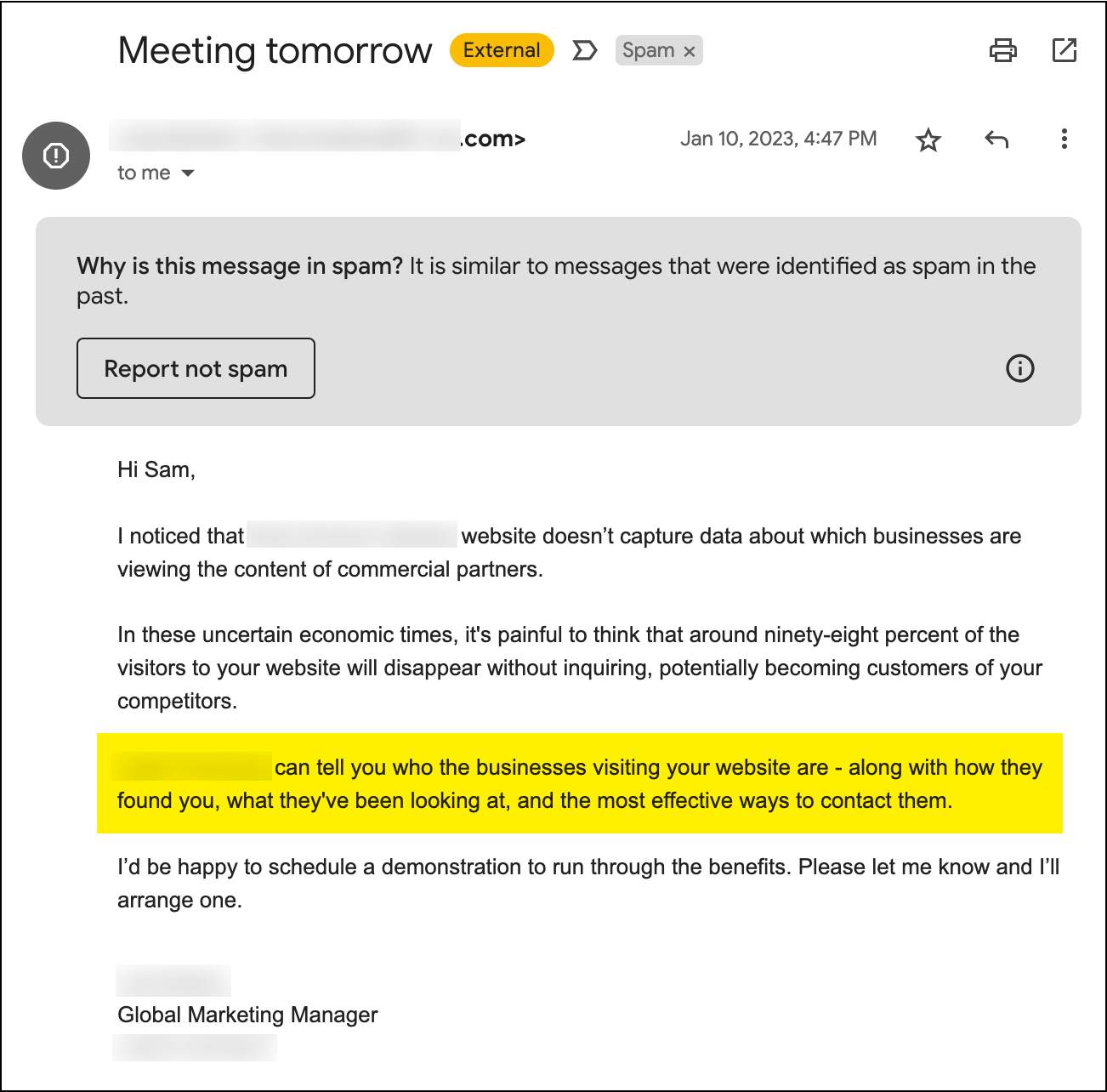
This tells me what the product does, and technically it does solve the problem. But the copy is sterile. It doesn’t give me any reason to use this company’s product. It’s not exciting or emotional.
Also, it’s selling me features, not results.
Beyond that, I’d speculate the reason the customer hasn’t solved the problem is either they didn’t know this type of product exists or they assumed it was cost-prohibitive to get this type of service. The email I received doesn’t address either of those.
Here’s my revised version:
Did you know… it’s possible to capture those leads even if they don’t fill out your form? At [Company], we created a revolutionary tool that 5,000+ small businesses are using to find out who’s visiting, what they’re looking at, and their contact info.
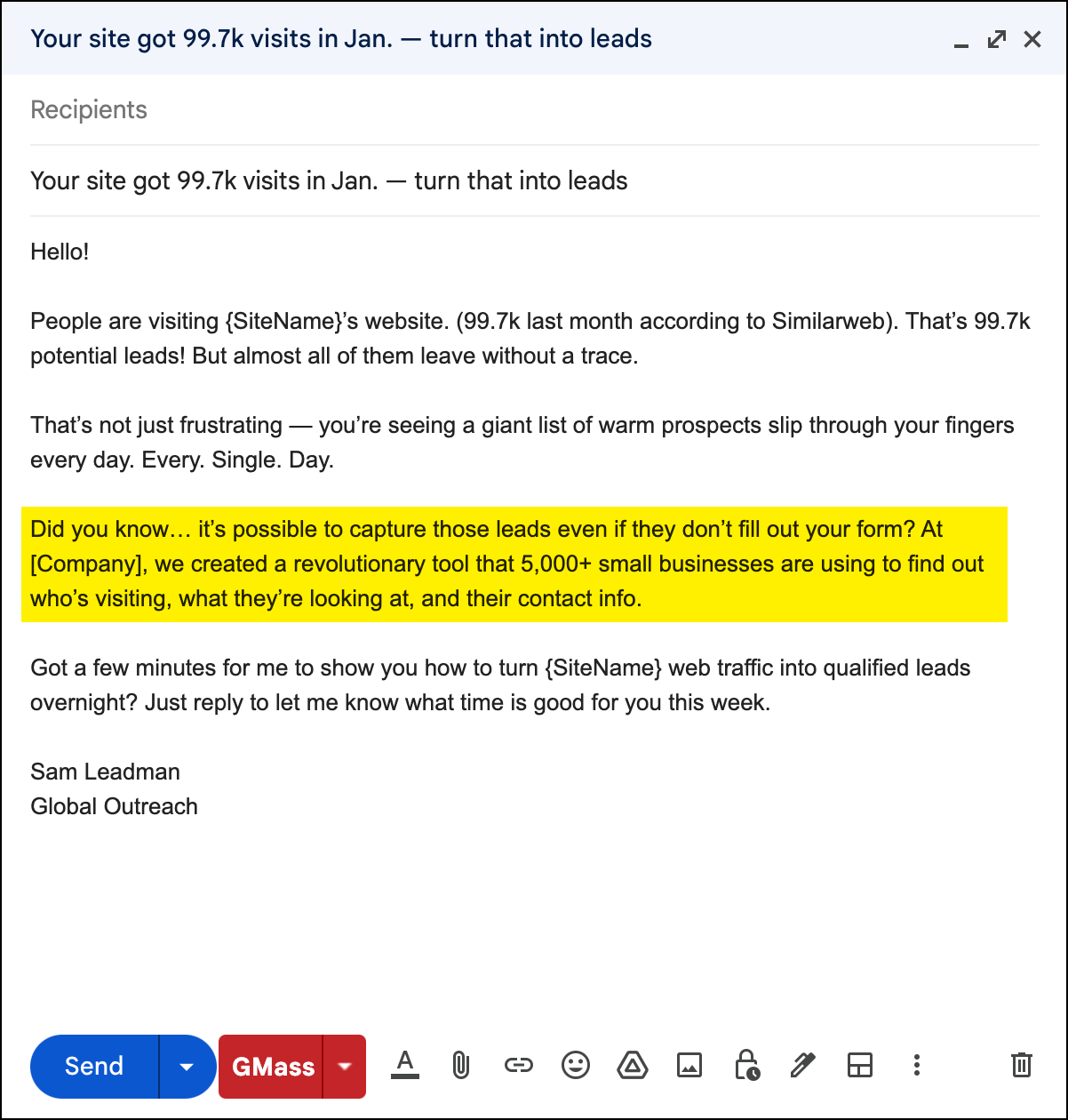
In this paragraph I’m addressing the reason why they haven’t solved the problem already (they didn’t know they could).
I then demonstrate what the tool can do — while simultaneously dropping social proof and differentiators.
I used the word “revolutionary” which is a power adjective; other options could’ve been something like “powerful” or “unique.” It all depends on what best describes your offer.
I dropped in the “5,000+” as social proof. I’m demonstrating that lots of people are using my product — but not so many that they’ve saturated the market.
And “small businesses” is a crucial word choice. That’s my way of signaling that my product is affordable to businesses like theirs.
4. Call-to-Action: How to End Your PAS Email
Why isn’t the call-to-action step incorporated into PAS?
Maybe because PASC is a worse acronym.
But I’ll say it’s separate because, if you’ve done your job right with the PAS email, the call-to-action is a no-brainer.
That being said… it’s always worth testing different CTA options (you can even test them live with GMass’s simple A/B testing). You could tell people to book a demo via a Calendly link. You could tell them to reply to get started. You could start a conversation where you tell them to reply to learn more.
Regardless of what you choose, the usual cold email CTA principles apply:
- Make the request clear and simple
- Make one single request in the email
- Aim to create a sense of urgency and/or scarcity
Putting together the call-to-action of your email
Here’s the CTA in the email I received:
I’d be happy to schedule a demonstration to run through the benefits. Please let me know and I’ll arrange one.
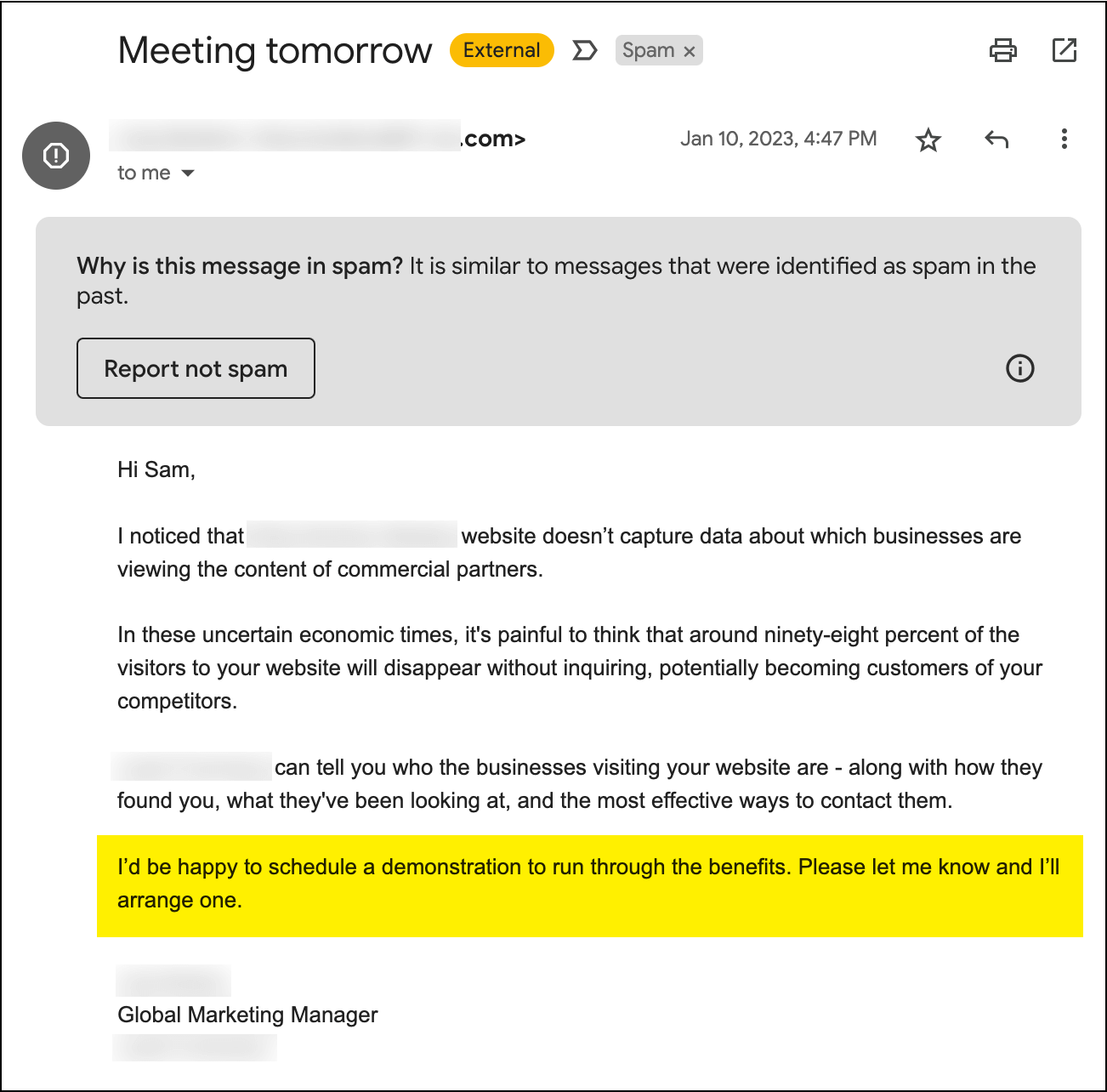
A few mistakes stick out to me here.
One, “run through the benefits” is a waste. Why not spell out the benefits instead?
And two, something about the way this is phrased makes it feel like the demo will happen when it’s convenient for them, not me.
Here’s the CTA in my PAS example:
Got a few minutes for me to show you how to turn {SiteName} web traffic into qualified leads overnight? Just reply to let me know what time is good for you this week.
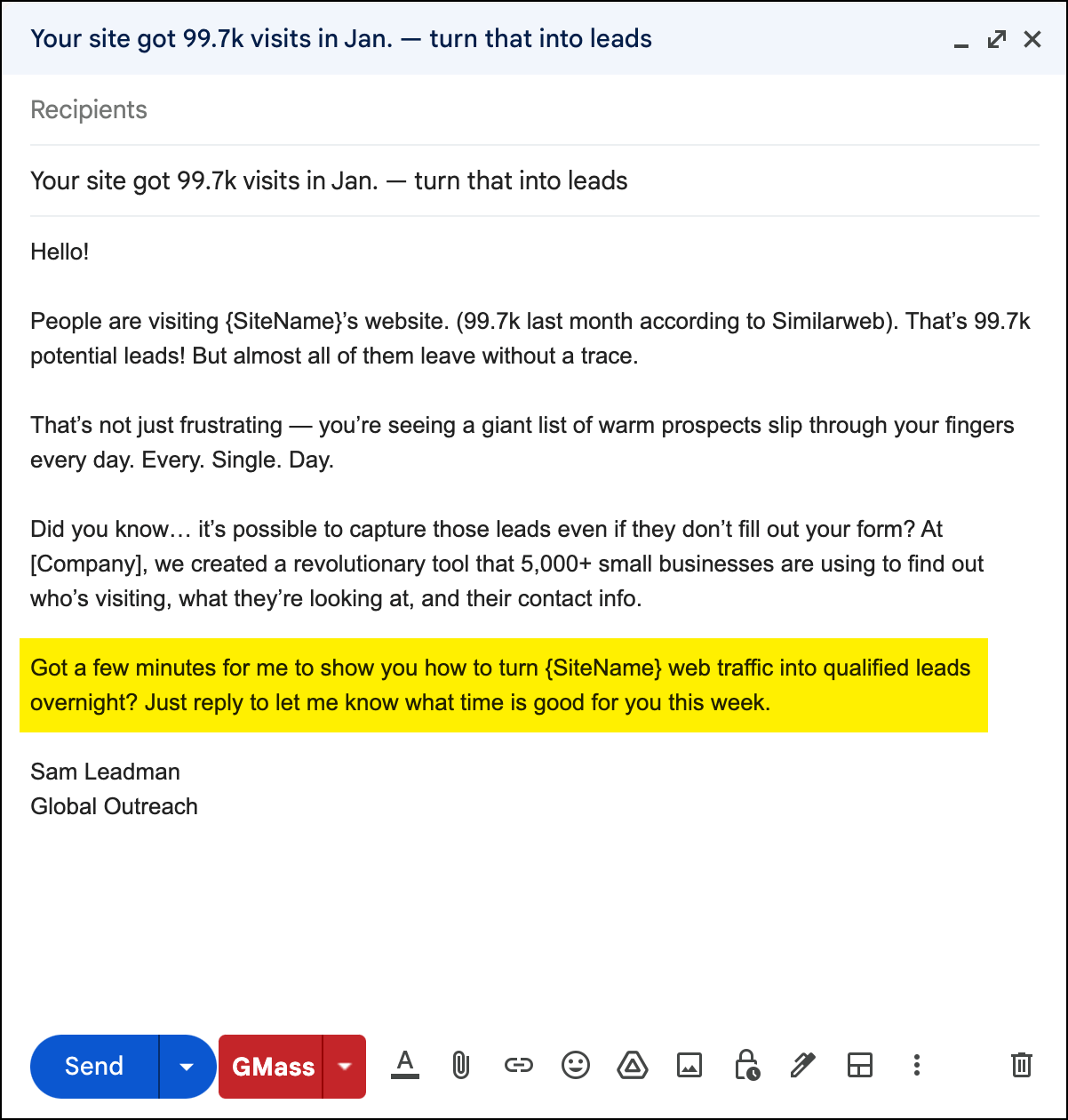
I’m setting a low time expectation here, restating the value proposition, and creating a little subtle urgency (“overnight” and “this week”).
I explicitly ask the person to reply and make it clear I’ll work around their schedule.
And note: I kept this email short, at 126 words. The storytelling aspect of the PAS method isn’t a license to blow past the standard 150-word ceiling for cold emails.
5. The Best Automated Follow-Up to a PAS Campaign
The PAS email should be compelling on its own, but odds are you won’t get a 100% reply rate.
PAS campaigns can benefit from automated follow-ups (just like any other cold email campaigns).
And you should follow up by further agitating the problem.
After all, you want to make it clear that by not taking action on your offer, the problem has now gotten worse for the prospect. And it will continue to get worse until they hire you to fix things.
Putting together the automated follow-up to your email
Here’s the follow-up I received to the original cold email from this campaign. It arrived six days later.
Subject: FW: Time this week?
Message: Hey Sam,
Did you catch my last email below?
I have some slots for tomorrow. Or would later this week work better?

This follow-up isn’t doing anything to get me excited about the offer. If I wasn’t motivated to reply the first time, would this motivate me more? Doubtful.
Here’s the first follow-up email I would send.
Subject: 13,290 potential leads have visited your website since my last message
Message:
I reached out four days ago about [Company], which captures your web traffic and turns it into leads.
Since then, you’ve had approximately 13,290 visitors… and I’m guessing you didn’t get 13,290 inquiries.
Let me know when you’re available for me to give you a quick run through [Company] to show you how it IDs your traffic and finds their contact info for you.
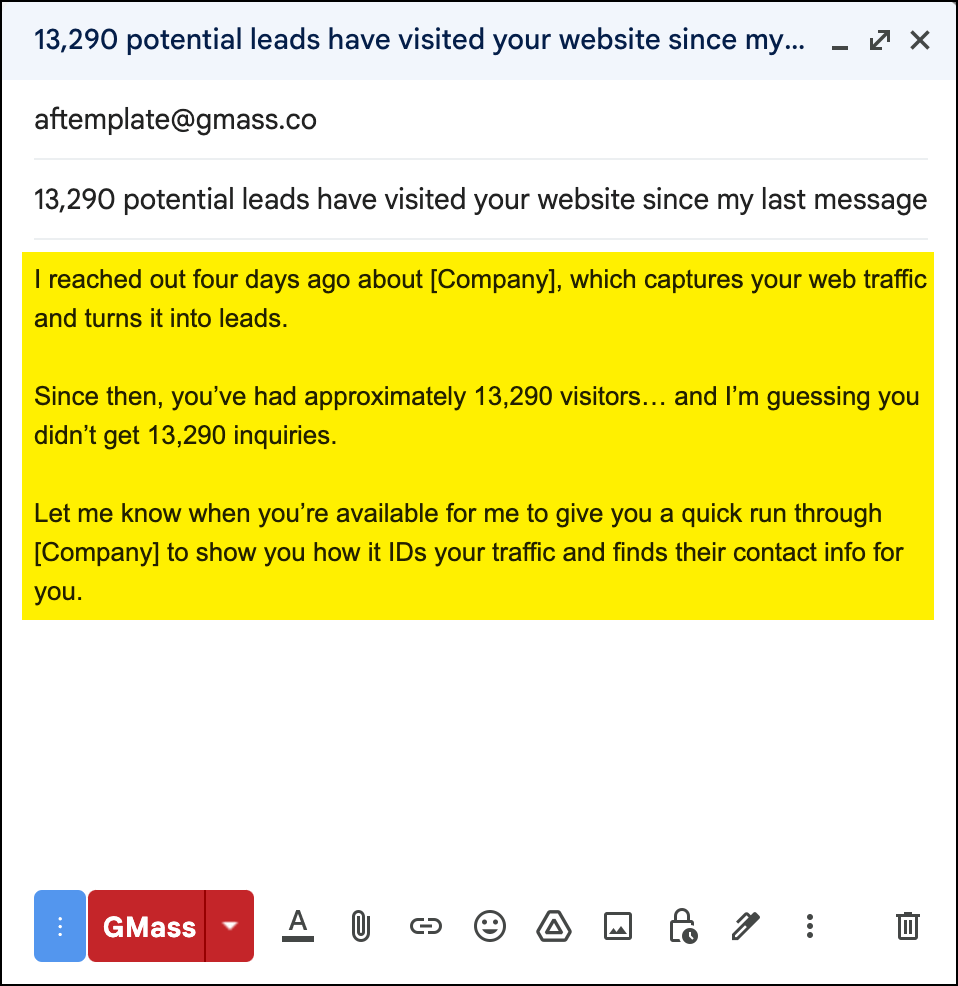
With this email, I’m agitating the problem by using numbers (I divided their web traffic by 30) to show them how things keep getting worse. And then I include another call-to-action, phrased a bit different than my first one, to try to earn a reply.
From here, you could try a few other follow-up styles. You could try switching to a scheduling link from a reply. Address other roadblocks they might have (like price or complexity to get started). You could even offer to have them skip the demo step to just start a trial.
Keep following up, keep agitating, keep solving, and keep creating a sense of urgency.
PAS Copywriting for Cold Email: Takeaways and Next Steps
The Problem-Agitate-Solve method is a sophisticated blend of personalization and emotionally-charged copywriting that can deliver major results.
The method differs from the AIDA formula in that it doubles down on the prospect’s problem and is tighter on the solution. But in many cases, the emotional hook of PAS copywriting will be the thing that turns your prospects into customers.
To review, the elements of the PAS formula are:
- P for Problem. You need to accurately identify the prospect’s specific problem. Ideally you’ll address the top problem that’s currently causing them pain.
- A for Agitate. The secret sauce of the PAS formula is to agitate the problem by describing the downsides of not fixing it.
- S for Solve. Here you reveal how you’ll solve the problem and why you specifically have the product or service to solve that problem.
- Call-to-action. Though a CTA isn’t part of the acronym, a PAS cold email needs to end with a strong call-to-action that creates a sense of urgency.
And make sure to queue an automated follow-up sequence where you continue to agitate and hit on different aspects of your solution.
If you’re looking for the right cold email platform to pull this off… it’s GMass.
And now — I’ll use the PAS method to demonstrate why.
It’s a struggle to find a cold email platform that checks all the boxes you need as a pro: Ease of use, high deliverability, every feature you want and need, and a reasonable cost.
So you’re finding your campaigns aren’t working. Your sends are capped. You can’t figure out how to do basic things. Your deliverability is poor. And that all means wasted leads and missed sales.
GMass has everything you’re looking for.
- It works inside Gmail and has just one settings box, making it as easy to use as regular email.
- 99% of GMass users report the best deliverability they’ve ever had. Not only are the emails going through Gmail’s high-deliverability servers, GMass offers things like Spam Solver and custom tracking domains with SSL to get you into the inbox.
- GMass has pretty much every cold email feature you could dream of — and gives cold email pros like you the ability to tweak those settings to your exact liking.
- And in spite of all that, GMass is still the most cost-effective cold email platform out there.
Join the 300,000+ users who’ve given GMass an incredible 4.8-star average rating across 7,500+ reviews in the Chrome Web Store.
To get started, just download the Chrome extension. There’s no credit card required for the free trial. And with our quickstart guide, you’ll be sending your first PAS campaign in minutes.
Email marketing, cold email, and mail merge all in one tool — that works inside Gmail
TRY GMASS FOR FREE
Download Chrome extension - 30 second install!
No credit card required
